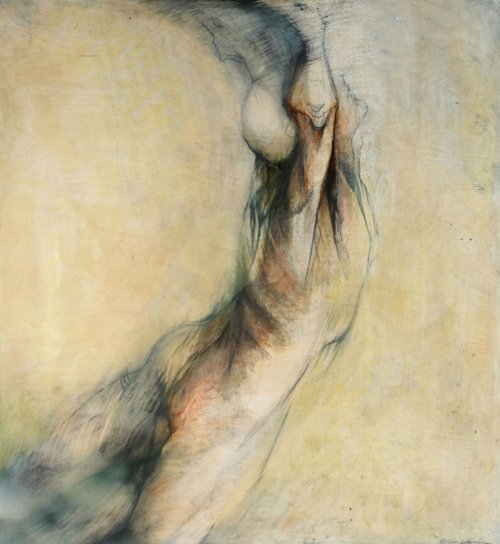A Tale of Two Bodies
Erica Grimm, “Ascending Arc” (2002), encaustic on Baltic birch.
One of the most common ways that Christians have read the story of the physical body is as a narrative of decline. The tale goes something like this.
At one time in the primordial past, the body was good. It was good for tasting delectable foods; it was good for tilling the garden; it was good for becoming “one flesh,” among other things.
But then sin entered the world and ruined everything. Most especially, however, it ruined the body. The body became the root of every bad thing that happened to humans: disordered relations, disordered work, disordered love of creaturely things, disordered imaginations, and disordered worship.
Because of its unruly powers, the body would now need to be tamed, tortured, or transcended, as the circumstances demanded.
On this telling of the body’s tale, the good bodies of Genesis 1 become the unfortunate bodies of Romans 7.
The blessed flesh of humans in Genesis 2 turns into the dangerous flesh of the saints in Romans 8.
The kinetic bodies of Miriam and David turn into the reserved bodies of the Christians at Corinth.
The maximalist bodies of the Psalter are exchanged for the modest bodies of 1 Timothy.
And the sensuous bodies of Israel’s worship are swapped for the sober bodies of the early church’s worship.
Ed Knippers, "The Resurrection" (2010) oil on panel.
The tale that I tell in my book, A Body of Praise, is a very different tale of the body.
It is the tale of a body that, while disfigured by sin, does not lose its image-bearing glory. It is the tale of a body that is defined by the body of Jesus and that is determined by the economy of the Spirit. It is the tale of a body that gives and receives the healing touch of God.
It is the tale of a body whose fundamental problem is not its “fleshiness” but rather its captivity to the forces of sin and death.
It is the tale of a body that experiences now a Spirit-ed foretaste of our new creation bodies, prefigured in the glorified flesh of Christ.
And it is the tale of a good body that remains central to the recreative purposes of the Trinity, here and now, in the worship of the church.
In order to tell this tale, however, we have to read Scripture with fresh eyes and in conversation with saints past and present—with theologians and artists and mystics, among others.
And that's the adventure of my book which I invite readers to embrace!
Greta Leśko, "Boże Narodzenie" (2021).
Kreg Yingst, "St. Francis kisses the Leper (Face your Fears/Affronta le tue Paure)," block print.
Caitlin Connolly (with Sarah Winegar), "Woman With an Empty Womb" (drawing-oil transfer).





